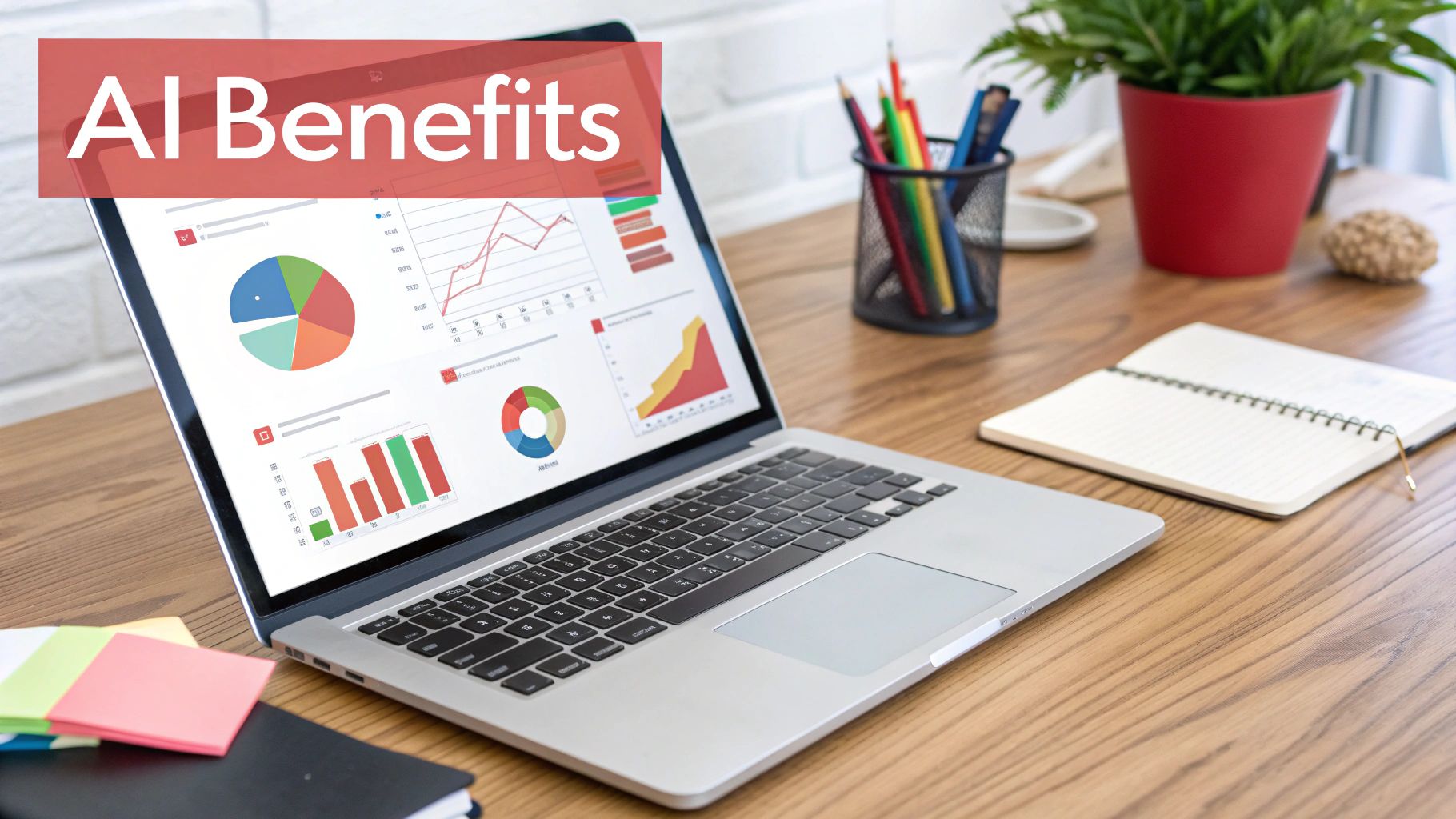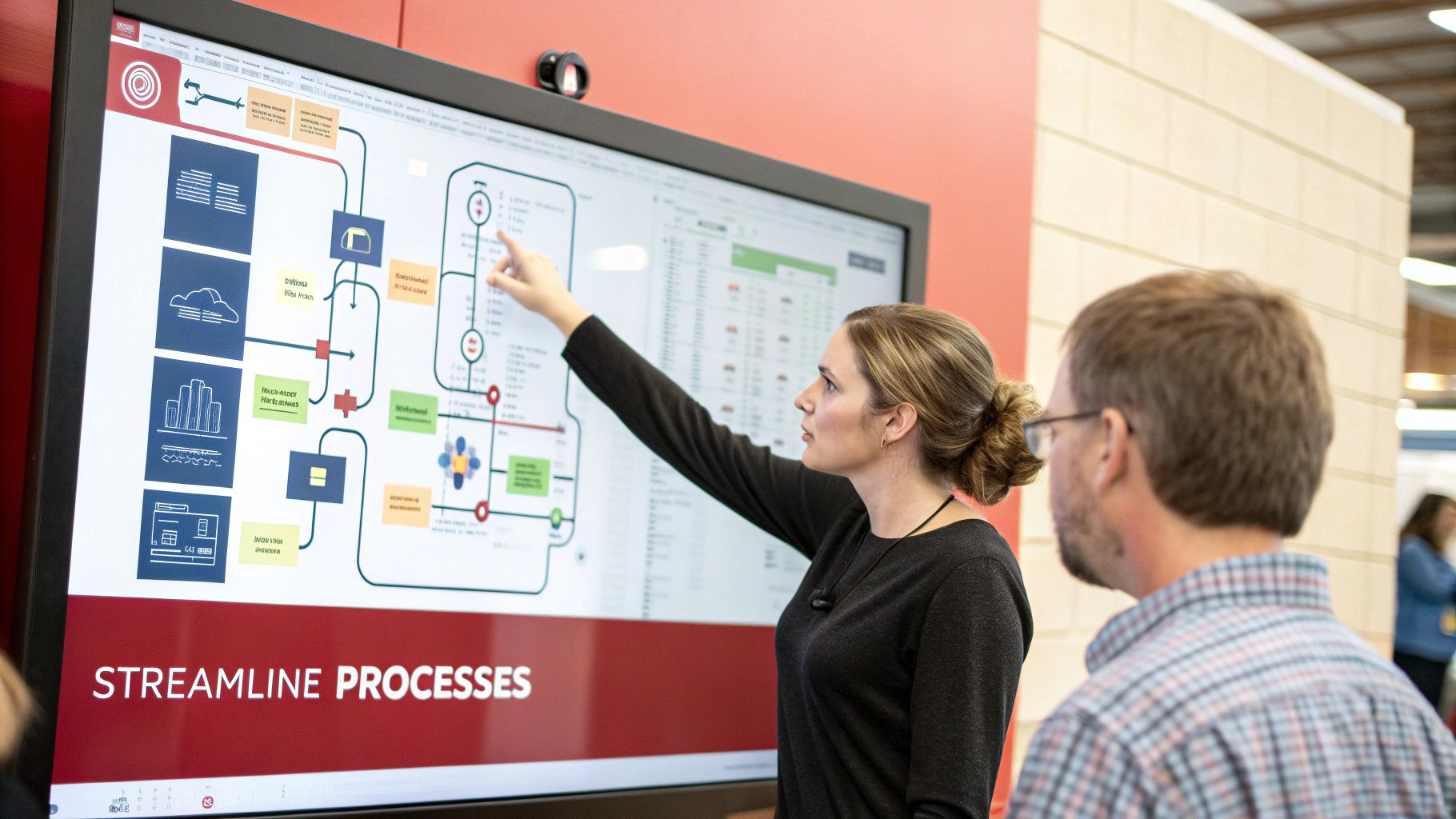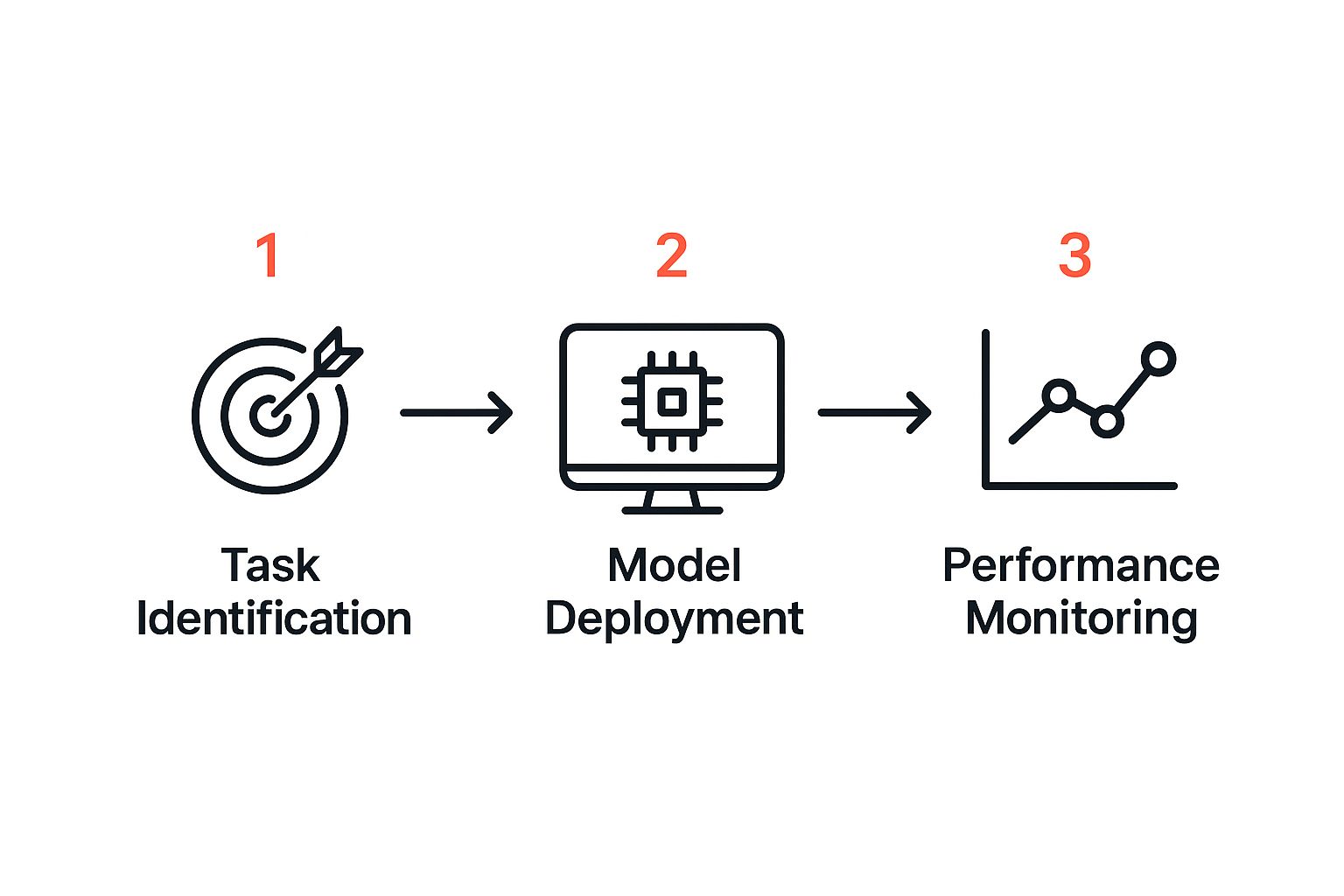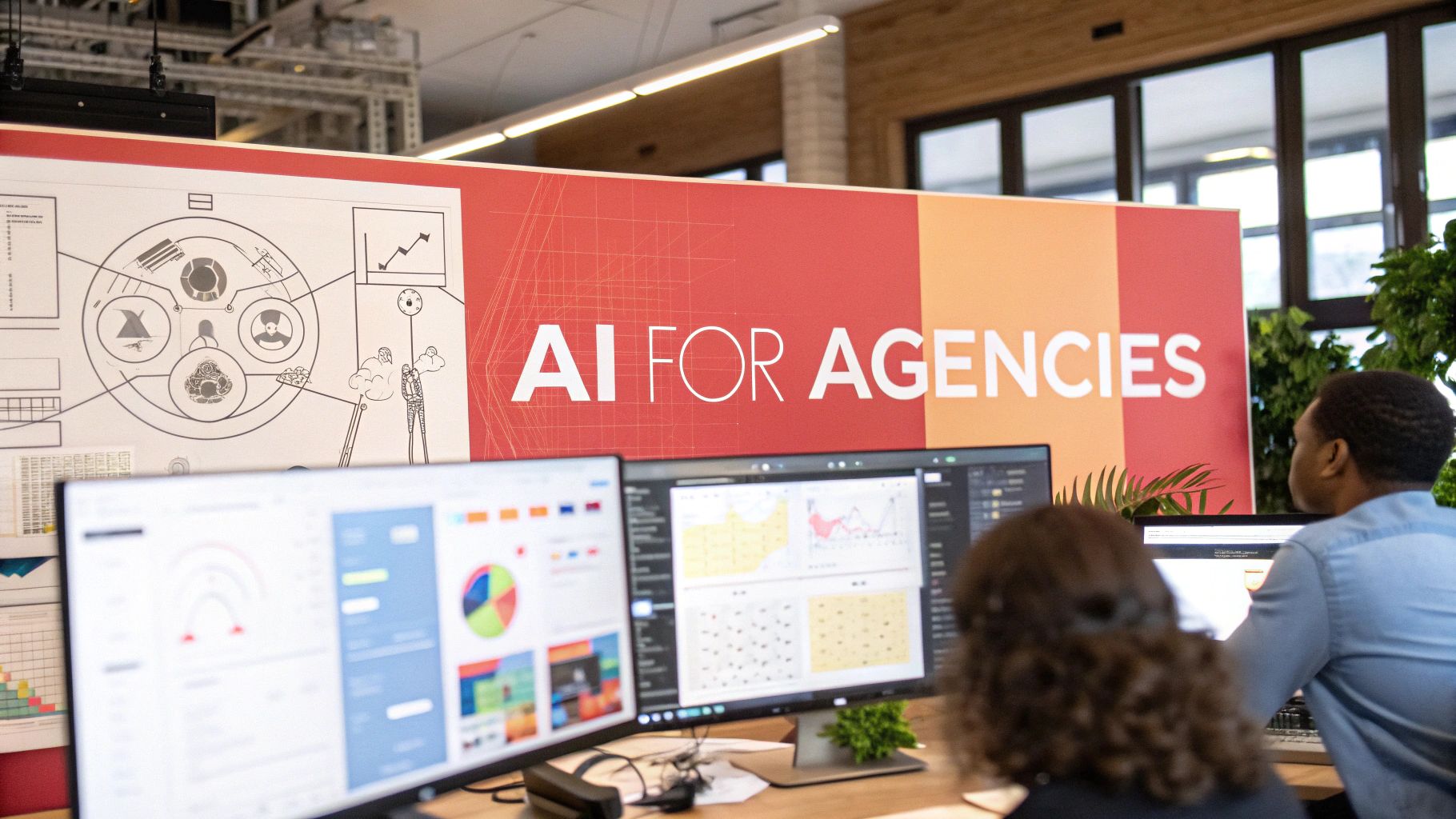AI for agencies isn't a futuristic concept anymore. It's the new operational standard, and adopting it is quickly becoming the key to staying competitive. Think of it as a powerful co-pilot for your agency—one that automates tedious tasks and unearths deep client insights. This empowers your team to focus on the high-value strategic and creative work that truly moves the needle for your clients.
Why AI Is No Longer Optional for Modern Agencies
Remember design agencies in the 90s? Imagine one stubbornly sticking to drafting tables and rulers, refusing to switch to digital software. While they painstakingly drew blueprints by hand, their competitors were using computers to create, edit, and ship incredible visuals in a fraction of the time.
That gap in speed, efficiency, and pure capability quickly became a chasm they couldn't cross. Today, agencies that turn a blind eye to AI are standing on that same precarious cliff edge.
This isn't just about adding another tool to your agency's tech stack. It's a fundamental shift in how agency work gets done. Today’s clients expect faster turnarounds, deeper data analysis, and more impactful results. AI is the engine that helps your agency meet—and exceed—those demands.
Gaining a New Competitive Edge in the Agency Landscape
The real advantage of using AI for agencies is the ability to operate at a speed and scale that is simply not humanly possible. We're seeing this across the board. The fact that platforms are baking AI into their core products, like Google Ads' major AI initiatives, tells you everything you need to know. When the tools of the trade become AI-driven, you can’t afford to show up with a manual toolkit.
An agency running on AI can:
- Analyze campaign data in minutes, not days, to pinpoint exactly where to optimize.
- Generate dozens of creative concepts for ad copy or social posts, giving your human team a massive head start.
- Automate technical SEO audits that used to eat up hours of billable time, getting to the strategic fixes faster.
This speed creates a massive competitive gap. While one agency is still manually pulling data for a quarterly report, their AI-augmented competitor has already analyzed the data, found three new audience segments, and pitched a proactive campaign to their client. Who do you think looks more valuable?
Before we dive into specifics, it's helpful to see where AI is making the biggest waves. This table gives a quick snapshot of how AI is reshaping the day-to-day of agency life.
How AI Is Transforming Core Agency Functions
This is just the tip of the iceberg, but it shows how AI isn't just one thing—it's a layer of intelligence that enhances almost every part of an agency.
Think of AI as an intelligence amplifier, not a replacement for your agency's talent. It handles the monotonous, data-heavy lifting, freeing your team to focus on what humans do best: building client relationships, understanding market nuances, and delivering breakthrough creative strategy.
At the end of the day, this isn't about chasing shiny objects. It’s about survival and growth. Bringing AI into your agency is a core business decision that directly impacts your ability to win new clients, keep the ones you have, and boost your bottom line. The question is no longer if an agency should adopt AI, but how quickly it can integrate these tools to secure its future.
Practical AI Use Cases for Your Agency's Daily Operations

Alright, let's move past the high-level strategy and get our hands dirty. How is AI for agencies actually showing up in the day-to-day grind? The real magic happens when you point these tools at the specific, nagging problems that every agency team knows all too well.
Think about it. Imagine an AI automatically summarizing a two-hour client discovery call, spitting out a perfect list of key decisions, action items, and even flagging potential upsell opportunities. This isn't some far-off dream; it's a real-world application that saves account managers hours and ensures nothing falls through the cracks. This is where the theory gets real for agency life.
Streamline Client Operations and Reporting
Your client-facing teams are the heart of your agency, but so much of their time gets eaten up by admin work. AI can step in as a tireless assistant, handling the repetitive stuff so your team can focus on building relationships and thinking strategically.
For example, meeting intelligence tools can transcribe and analyze every single client call. Suddenly, you have a searchable knowledge base of every conversation. Need to remember what a client said about their Q3 budget two months ago? A quick search brings up the exact quote and context. No more guessing.
A huge chunk of an account manager's week is burned on post-meeting admin. AI tools can slash that time by over 50% by automating tasks like writing summaries, drafting follow-up emails, and creating tasks in your project management software.
These tools are also goldmines for forecasting. By crunching the numbers on past projects—timelines, team hours, final costs—predictive AI can help you build much more accurate proposals. This isn't just about better planning; it's about protecting your agency's profit margins and stopping scope creep before it starts.
Supercharge Your Creative and Content Production
For creative teams, AI isn't a replacement; it's a co-pilot. Think of it as a brainstorming partner that never gets tired, capable of generating hundreds of concepts in minutes. It’s the perfect way for your agency to shatter a creative block and find a fresh angle for any client campaign.
Here’s how agency creatives are using AI right now:
- Drafting dozens of ad copy variations for A/B testing, playing with different tones and hooks.
- Generating visual concepts and mood boards to get the design process rolling.
- Creating solid first drafts of blog posts or web copy from just an outline and a few keywords.
- Repurposing existing content for new channels, like turning a detailed case study into a week's worth of social media posts.
The human creative then steps in to do what they do best: refine, elevate, and inject the strategic nuance and brand voice that only a person can. It's all about speeding up the early, often tedious, parts of the creative workflow.
Unlock Deeper Marketing and SEO Insights
When it comes to digital marketing and SEO, AI is a data-analysis beast. These tools can chew through massive datasets to spot patterns and opportunities that a human analyst in your agency, no matter how skilled, might easily miss.
Take technical SEO. An AI tool can crawl a huge enterprise-level website and spit out a prioritized to-do list of issues, from broken links to schema errors, in a tiny fraction of the time it would take to do manually. This frees up your SEO experts to spend their time fixing problems for clients, not just finding them.
In performance marketing, AI can also:
- Uncover hidden audience segments by analyzing conversion data across all your platforms.
- Optimize ad spend in real-time, automatically shifting your budget to the campaigns that are actually working.
- Predict campaign performance based on historical data, helping you set more realistic expectations with clients.
This level of insight turns your marketing team from reactive to proactive. They're no longer just reporting the numbers; they're armed with data-backed intelligence to drive much better results for your clients.
Enhance Agency Project Management and Workflow
Efficiency is the lifeblood of any agency. AI is quickly becoming a project manager's best friend, helping to smooth out operations and keep things on track. Smart tools can now predict project bottlenecks before they derail your timeline, making sure teams aren't overloaded and deadlines are actually met.
For a deeper look at this, exploring a list of agency project management tools can show you which platforms are already building these features in.
By automating resource allocation and task scheduling based on team capacity and project priority, AI helps PMs make smarter, data-driven decisions. It can even generate initial project plans and timelines straight from a client's proposal. That alone saves a ton of setup time on every new project, letting your team get to work and start delivering value that much faster.
How to Build Your Agency's AI Tech Stack

Jumping into AI for your agency can feel like being dropped into a massive, noisy warehouse filled with thousands of shiny new tools but no instruction manual. It seems like a new must-have platform launches every single week, making the simple act of choosing the right tech completely overwhelming.
But here’s the secret: the goal isn’t to grab the most expensive, feature-packed AI tool on the shelf. It’s about thoughtfully putting together a smart, scalable tech stack that solves the actual problems your agency faces every day.
A simple way to cut through the chaos is to think about your tech stack in tiers. This method helps you prioritize your spending, start small, and then scale up your capabilities as your team gets more comfortable and your clients' needs evolve. It’s a smart way to avoid sinking a ton of cash into fancy software before you've even proven its worth.
This tiered framework is all about building a solid foundation with general-purpose tools before you start adding the more specialized—and expensive—platforms. It's a strategic approach to weaving AI into your agency's DNA without breaking the bank or blowing up your existing workflows.
Tier 1: Foundational AI Tools for Every Team Member
Think of this first tier as your everyday essentials. These are the low-cost, high-impact tools that pretty much everyone in your agency can and should be using. They're the versatile Swiss Army knives of the AI world, built to handle universal agency tasks and deliver quick efficiency wins with very little training or investment.
The main goal here is simple: get your team comfortable with using AI daily. These tools typically excel at:
- Content Generation: Helping draft emails, social media updates, or initial blog post outlines.
- Meeting Intelligence: Automatically transcribing calls, pulling out summaries, and flagging action items from client meetings.
- Brainstorming: Kicking off creative sessions by generating ideas for campaigns, taglines, or new angles.
Key Insight: Your Tier 1 stack should be all about crushing common administrative bottlenecks. An agency that can automate meeting notes and first-draft content frees up dozens of hours every single week. That’s more time for your team to focus on what they do best: client strategy and high-value creative work.
As you build out this foundational layer, it's smart to look for tools that give your team a real creative edge. Integrating some of the best AI tools for content creators is a great way to do this. These platforms create the solid base you'll need before moving on to more advanced capabilities.
Tier 2: Specialized Platforms for Your Agency's Core Services
Once your team has the hang of the foundational tools, it's time for Tier 2. This is where you get more strategic, investing in specialized platforms that directly power up your core services. These tools are definitely more specific and often come with a higher price tag, but they should deliver a crystal-clear return by improving the quality and speed of your agency's main offerings.
For example, a performance marketing agency might invest in an AI platform that optimizes ad spend in real-time. An SEO agency could bring in a tool that automates gnarly technical audits or provides sophisticated content optimization suggestions. The key is to draw a straight line from the tool to a service your agency actually sells.
Tier 3: Custom and Advanced AI Solutions for a Competitive Edge
Tier 3 is the top of the mountain for AI adoption. At this level, your agency is moving past off-the-shelf software and into the world of custom-built solutions or highly advanced platforms that give you a unique, powerful edge over the competition.
This might look like developing a proprietary AI model to predict market trends in your specific niche. Or it could mean connecting multiple AI systems via APIs to create a totally seamless, automated workflow from the moment a client signs on to the final report you deliver.
This isn't where you start; it's a destination you work toward. Getting to this tier requires a deep, intimate understanding of your agency’s data, processes, and people. It’s a major undertaking, but getting it right can give your agency a powerful, one-of-a-kind asset that nobody else has.
Overcoming Common AI Implementation Hurdles in an Agency Setting
Adopting AI can feel like a massive opportunity for your agency, and it is. But ignoring the potential roadblocks is like sailing into a storm without checking the weather first. Making a smooth switch from your tried-and-true workflows to an AI-powered model means having an honest conversation about the real-world challenges your agency will face.
Getting AI for agencies right isn't just about buying new software. It’s about tackling tricky issues like data privacy, getting your team up to speed, and actually proving it's worth the investment. Think of this as your practical playbook for seeing these hurdles coming and handling them like a pro, making your agency's jump into AI successful, not stressful.
Safeguarding Client Data and Your Agency's Intellectual Property
Let's start with the big one: data security. The second your team starts pasting client information into public AI tools, you have to ask: where is that data really going? This isn't just a theoretical "what if." It's a real and immediate risk every agency leader needs to get in front of. Without clear rules, you’re gambling with confidential client strategies, their customer data, and even your own agency's hard-won intellectual property.
The problem gets bigger when you realize how quickly employees jump on these tools, often without any official green light. A recent global study from KPMG painted a pretty startling picture: 46% of U.S. workers admit they’ve uploaded sensitive company info to public AI tools. On top of that, 44% are using AI at work without getting proper permission. And yet, everyone sees the potential—61% say AI is already making a positive difference in their work. You can read more about these findings on AI trust from KPMG to see the full scope.
This gap between risk and reward screams for one thing: clear agency governance. You need a firm policy that spells everything out.
- Approved vs. Banned Tools: Make a simple list. These AI platforms are vetted and safe for client work. These are not. End of story.
- Data Handling Protocols: Be crystal clear about what kind of information can—and absolutely cannot—be put into any AI system.
- Client Communication: Be upfront with your clients. Tell them how you're using AI to get them better results while keeping their data locked down.
Bridging the Team Skill Gap Through Targeted Training
The next hurdle is your people. Dropping powerful new tech on your agency team almost always creates a gap between the skills they have and the skills they now need. Just handing them logins to a new AI tool without any real training is a perfect recipe for a wasted investment and a whole lot of frustration.
But here's the good news: you don't need to turn everyone into a data scientist. The real skill to focus on is prompt engineering—the art and science of asking AI the right questions to get back high-quality, genuinely useful answers. This is the new must-have skill for modern agency pros.
Think of it this way: AI is like a brilliant but very literal junior employee. It can do amazing things, but only if you give it clear, specific, and well-contexted instructions. Vague requests lead to generic, unusable output for your clients.
To close that skill gap, you need to build a culture where learning is constant.
- Start with "Low-Stakes" Training: Let your team practice on internal agency projects, like your own marketing. It's a safe sandbox for them to experiment without client pressure.
- Encourage Knowledge Sharing: Set up a Slack channel or a weekly huddle where people can share prompts that worked, cool tricks they've found, and workflows that are saving them time.
- Focus on Augmentation, Not Replacement: Frame AI as a copilot that helps them do their best work, faster. It’s there to handle the boring stuff, freeing them up for the high-value strategic work. Speaking of which, AI is a master at tackling tedious work, which you can learn more about in our guide on how to automate repetitive tasks.
Proving ROI and Protecting Client Brand Voice
Last but not least, you have to make the numbers work and protect your clients' brands. How do you actually prove the financial return on an AI tool? And maybe more importantly, how do you stop AI-generated content from sounding like a generic, soul-less robot, erasing the unique brand voice you've worked so hard to build for a client?
Measuring ROI is about more than just "time saved." You need to track metrics that connect directly to your agency's bottom line and your clients' success.
- Proposal Win Rate: Are AI-powered insights helping you craft proposals that land more clients?
- Client Retention: Is the faster, more data-driven service leading to happier clients who stick around longer?
- Project Profitability: Are you finishing projects quicker and with fewer resources, directly boosting your agency's profit margins?
As for brand voice, the secret is a human-in-the-loop approach. AI should write the first draft, never the final word. Your team's role evolves into that of an expert editor. They take the AI's output and inject the brand personality, strategic nuance, and emotional connection that only a human can deliver. This way, your agency gets all the efficiency gains of AI without ever sacrificing the quality and authenticity your clients are paying you for.
Your Agency's Step-by-Step AI Integration Roadmap
Bringing AI into your agency isn't something you do overnight. If you just jump in headfirst without a clear plan, you're setting yourself up for wasted money and a seriously frustrated team. Think of it less like flipping a switch and more like a deliberate, phased process.
A solid roadmap takes the huge, overwhelming idea of "adopting AI" and breaks it down into a series of clear, manageable steps. It's all about starting small, proving the value to your agency, and then scaling up intelligently.
Phase 1: Start With an Internal Agency Audit
Before you even glance at a single AI tool, you need to look inward. The very first step is a thorough internal audit to find your biggest operational headaches and opportunities. Where is your agency bleeding time? What are the repetitive, soul-crushing tasks burning out your best people?
Put on your detective hat and investigate your own workflows.
- Map Your Processes: Write down the key steps for your core services, from bringing on a new client to delivering a final campaign report.
- Identify Pain Points: Where do things grind to a halt? What tasks do your team members universally dread? This is usually where AI can deliver the biggest and fastest wins for your agency.
- Quantify the Problem: Try to put real numbers on the pain. For instance, "Our account managers spend about 5 hours per week, each, on manual reporting." This gives you a concrete baseline to measure success against.
This audit isn't about pointing fingers; it's about uncovering opportunities. The goal is to walk away with a prioritized list of problems that AI could realistically solve, giving you a clear target for your efforts.
Phase 2: Launch a Low-Risk Pilot Project
With your list of high-impact problems in hand, it's time to test the waters. Whatever you do, resist the temptation to launch a massive, agency-wide initiative right out of the gate. Instead, pick one or two specific issues from your audit and run a small, low-risk pilot project.
The whole point of a pilot is to prove that this stuff actually works on a small scale. For example, if your audit showed that drafting initial social media content calendars is a major time-suck, you could pilot a generative AI tool with just one social media manager on a single client account.
Key Insight: A successful pilot project is your best weapon for getting buy-in from the rest of the agency. When people see a colleague genuinely saving hours every week with a new tool, their skepticism quickly melts away and turns into real curiosity.
This approach keeps your initial investment low and contains any hiccups. It lets you try out different tools, see how they actually fit into your day-to-day, and get honest feedback before you go all-in.
Phase 3: Establish Clear AI Governance for Your Agency
As you start seeing those early wins from your pilot projects, you have to lay down some ground rules. AI governance isn't about tying your team's hands; it's about protecting your agency, your clients, and your reputation. This is the time to create a formal, easy-to-understand policy on AI usage and data security.
Your policy should be straightforward and answer the big questions for your agency:
- Which specific AI tools are approved for use with client information?
- What types of data are absolutely forbidden from being entered into any public AI model (think PII, confidential client strategy, etc.)?
- What is the mandatory human review process to ensure AI-generated content is accurate and still sounds like your client's brand?
This simple flow chart really nails the critical workflow for any task you hand over to AI.

It's a great reminder that AI isn't a "set it and forget it" magic button. To do it right, you have to identify the right task, use the right model, and then keep a close eye on its performance to make sure the quality is there.
Phase 4: Train Your Team and Scale Deliberately
Okay, you've got a successful pilot under your belt and clear rules in place. Now you're ready to scale. This phase is really about two things happening at once: training your agency team and rolling out the proven tools to more people. Good training isn't just a demo; it focuses on practical skills, like prompt engineering, that help your team get incredible results from the AI.
Scaling shouldn't be a floodgate. Expand access team by team or department by department, using the wins from your pilot as an internal case study. You need to keep measuring the impact against the baselines you set way back in your audit. Are those 5 hours of reporting time shrinking? Is content getting out the door faster? These numbers are what prove the real, ongoing value of using AI for agencies.
This measured approach to scaling is also a cornerstone of great project management for agencies, making sure new tools and processes are adopted smoothly and actually stick.
The Future Is the AI-Augmented Agency

Let's clear the air on one of the biggest myths floating around the agency world: the idea that AI is coming for every agency's lunch money. The reality is far more interesting. The agencies that thrive in the coming years won't be replaced by AI; they'll be supercharged by it, creating a powerful new way of working.
Welcome to the era of the AI-augmented agency. In this model, technology isn't taking over—it’s taking on the grunt work that saps your team's energy and creativity. Think of it as a force multiplier for your talent. By letting AI handle the repetitive, data-heavy lifting, you free up your best people to do what they do best.
This smart division of labor gives your agency team the breathing room to focus on building real client relationships, dreaming up game-changing campaign strategies, and cracking the complex creative problems that no algorithm can touch.
Redefining Your Agency's Service Offerings
When your team isn't bogged down by the daily grind of manual data pulls and mind-numbing admin tasks, something incredible happens. Their capacity for high-value work explodes. The AI-augmented agency doesn't just do the same old things faster; it starts doing entirely new things.
This shift unlocks a whole new menu of services your agency can offer. Imagine being able to confidently offer:
- Predictive Analytics as a Service: Using AI to forecast market trends for clients with a startling degree of accuracy.
- Hyper-Personalization at Scale: Crafting unique, compelling customer journeys for thousands of individuals at once.
- Rapid Creative Prototyping: Developing and validating dozens of creative concepts in the time it used to take for just one.
The core value of an AI-augmented agency shifts from execution to insight. Clients stop paying you just for deliverables and start paying you for proactive, data-driven intelligence that gives them a genuine edge.
This isn't just a theory; it's happening right now. Between 2023 and 2024, the use of generative AI by U.S. federal agencies jumped from 32 to 282 distinct uses, and overall AI adoption nearly doubled. If the government is moving this fast to improve communication and speed up information access, it’s a clear signal for private-sector agencies to get on board. You can see how quickly federal AI adoption is accelerating to get a sense of the momentum.
From Threat to Your Agency's Biggest Growth Catalyst
Seeing AI for agencies as a threat is a viewpoint stuck in the past. Forward-thinking agency leaders see it for what it truly is: the single most powerful tool available for unlocking new levels of growth, creativity, and profitability.
Embracing the augmented model means your agency can:
- Boost Profit Margins: Automating low-value tasks lets you deliver better results more efficiently, which flows directly to your bottom line.
- Attract and Keep Top Talent: The best people want to solve exciting strategic puzzles, not get stuck in repetitive administrative loops.
- Build Deeper Client Partnerships: With more time for strategy, your teams can evolve from vendors into indispensable advisors.
The future isn't a battle of human versus machine. It's human with machine. By weaving AI thoughtfully into your daily workflows, you empower your people, elevate your services, and build a more innovative and profitable agency that's ready for whatever comes next.
Answering Your Agency's Top Questions About AI
Even with a clear plan, it's totally normal for agency leaders to have some lingering questions about what bringing AI into the fold actually looks like. Let's tackle a few of the most common concerns we hear all the time.
"How do I convince clients that our agency's use of AI is a benefit, not a shortcut?"
This is a big one. The key is to stop talking about the tool and start talking about the results. It's not about "using AI"; it's about what AI unlocks for them.
Explain that these tools allow your team to crunch data at lightning speed, uncover strategic insights that would have otherwise stayed hidden, and fine-tune campaigns with a level of precision that just wasn't possible before. Frame it as a performance-enhancing tool that supercharges your team's existing expertise. It frees them up from tedious, manual work to spend more time on high-level strategy and creative thinking—the stuff that directly grows the client's bottom line.
"What is the best first AI tool for a small agency on a tight budget?"
Don't overcomplicate it. Start with a versatile, low-cost generative AI platform like ChatGPT Plus or Google Gemini.
Think of these as the Swiss Army knife for a modern agency. They can help with everything from drafting initial content and brainstorming campaign angles to conducting quick market research. This approach lets your team experiment and discover where AI provides the most value for your specific workflow before you even think about investing in more specialized—and expensive—software.
"Will AI replace creative jobs at my agency?"
It's far more likely to evolve them. Seriously. Think of AI as a creative co-pilot, not the pilot.
AI is fantastic at generating a mountain of initial ideas or handling the repetitive, grunt-work parts of the creative process. But what it can't do is replicate the nuanced strategic thinking, emotional intelligence, and deep brand understanding that a human creative brings to the table. Your team's role will simply shift. They'll become the directors, the editors, and the strategists who guide the AI and elevate its raw output into something truly exceptional.
Ready to give your team the AI co-pilot they deserve? Scribbl automates meeting summaries, follow-ups, and CRM updates, saving each team member over 5 hours a week. See how it works.




